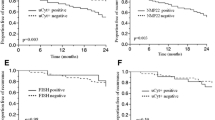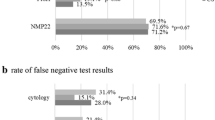Abstract
Introduction
Several influencing factors on false positive rates (FPRs) of urine-based tumor markers in the detection of urothelial cancer (UC) have been identified. We evaluated age as a possible influencing factor.
Methods
Urinary cytology (Cyt), UroVysion (FISH), ImmunoCyt (uCyt+) and NMP22 were determined in 1,554 patients suspicious for UC of the bladder before cystoscopy and in case of cancer detection before TURB. Additionally, upper urinary tract imaging was performed. Maker sensitivity, specificity and FPRs were evaluated in the entire cohort and in subgroups divided by age into <50, ≥50–70 and ≥70 years. Contingency tables and the Cochrane Armitage tests were used for statistical comparisons.
Results
UC was found in 377 and no UC in 1,177 (75 %) patients. A total of 336 patients were diagnosed with UC of the bladder and 41 with UC of the upper urinary tract. Overall sensitivity and specificity for Cyt were 82 and 82 %: for FISH, 73 and 79 % and for uCyt+, 79 and 75 %, respectively. For NMP22, regardless of the exclusion criteria they were 72 and 34 % and after exclusion of urinary tract infection (UTI) or prior to manipulation 46 and 86 %, respectively. Significantly higher FPRs were found with increasing age for Cyt (p = 0.001), a trend to higher FPRs for uCyt+ (p = 0.11) and almost no difference for FISH (p = 0.63). For NMP22, differences became significant after exclusion of patients with UTI or prior manipulation (p = 0.02).
Conclusions
The results of the present study give evidence that false positive rates of Cyt and NMP22 increase with age indicating that age should be respected for their correct interpretation.

Similar content being viewed by others
References
Tilki D, Burger M, Dalbagni G et al (2011) Urine markers for detection and surveillance of non-muscle-invasive bladder cancer. Eur Urol 60:484–492
Babjuk M, Oosterlinck W, Sylvester R et al (2011) EAU guidelines on non-muscle-invasive urothelial carcinoma of the bladder, the 2011 update. Eur Urol 59:997–1008
Lotan Y, Svatek RS, Sagalowsky AI (2006) Should we screen for bladder cancer in a high-risk population? A cost per life-year saved analysis. Cancer 1(107):982–990
Svatek RS, Lotan Y, Karakiewizc PI, Shariat SF (2008) Screening for bladder cancer using urine-based tumor markers. Minerva Urol Nefrol 60:247–253
Hennenlotter J, Huber S, Todenhofer T et al (2011) Point-of-care tests for bladder cancer: the influencing role of hematuria. Adv Urol 2011:937561
Pesch B, Nasterlack M, Eberle F et al (2011) The role of haematuria in bladder cancer screening among men with former occupational exposure to aromatic amines. BJU Int 108:546–552
Todenhofer T, Hennenlotter J, Witstruk M et al (2012) Influence of renal excretory function on the performance of urine based markers to detect bladder cancer. J Urol 187:68–73
Todenhofer T, Hennenlotter J, Tews V et al (2011) Impact of different grades of microscopic hematuria on the performance of urine-based markers for the detection of urothelial carcinoma. Urol Oncol
Shariat SF, Sfakianos JP, Droller MJ, Karakiewicz PI, Meryn S, Bochner BH (2010) The effect of age and gender on bladder cancer: a critical review of the literature. BJU Int 105:300–308
Madeb R, Messing EM (2004) Gender, racial and age differences in bladder cancer incidence and mortality. Urol Oncol 22:86–92
Papanicolaou GN, Marshall VF (1945) Urine sediment smears as a diagnostic procedure in cancers of the urinary tract. Science 18(101):519–520
Epstein JI, Allsbrook WC Jr, Amin MB, Egevad LL (2005) The 2005 international society of urological pathology (ISUP) consensus conference on gleason grading of prostatic carcinoma. Am J Pathol 29:1228–1242
Riesz P, Lotz G, Paska C et al (2007) Detection of bladder cancer from the urine using fluorescence in situ hybridization technique. Pathol Oncol Res 13:187–194
Kipp BR, Tyner HL, Campion MB et al (2008) Chromosomal alterations detected by fluorescence in situ hybridization in urothelial carcinoma and rarer histologic variants of bladder cancer. Am J Clin Pathol 130:552–559
Mian C, Pycha A, Wiener H, Haitel A, Lodde M, Marberger M (1999) Immunocyt: a new tool for detecting transitional cell cancer of the urinary tract. J Urol 161:1486–1489
Greene KL, Berry A, Konety BR (2006) Diagnostic utility of the immunoCyt/uCyt+ test in bladder cancer. Rev Urol 8:190–197
Karakiewicz PI, Benayoun S, Zippe C et al (2006) Institutional variability in the accuracy of urinary cytology for predicting recurrence of transitional cell carcinoma of the bladder. BJU Int 97:997–1001
Bubendorf L (2011) Multiprobe fluorescence in situ hybridization (UroVysion) for the detection of urothelial carcinoma—FISHing for the right catch. Acta Cytol 55:113–119
Hajdinjak T (2008) UroVysion FISH test for detecting urothelial cancers: meta-analysis of diagnostic accuracy and comparison with urinary cytology testing. Urol Oncol 26:646–651
Mian C, Maier K, Comploj E et al (2006) uCyt+/ImmunoCyt in the detection of recurrent urothelial carcinoma: an update on 1991 analyses. Cancer 25(108):60–65
Horstmann M, Patschan O, Hennenlotter J, Senger E, Feil G, Stenzl A (2009) Combinations of urine-based tumour markers in bladder cancer surveillance. Scand J Urol Nephrol 43:461–466
Shariat SF, Karam JA, Lotan Y, Karakiewizc PI (2008) Critical evaluation of urinary markers for bladder cancer detection and monitoring. Rev Urol 10:120–135
Atsu N, Ekici S, Oge OO, Ergen A, Hascelik G, Ozen H (2002) False-positive results of the NMP22 test due to hematuria. J Urol 167:555–558
Sharma S, Zippe CD, Pandrangi L, Nelson D, Agarwal A (1999) Exclusion criteria enhance the specificity and positive predictive value of NMP22 and BTA stat. J Urol 162:53–57
Huber S, Schwentner C, Taeger D et al (2012) Nuclear matrix protein-22: a prospective evaluation in a population at risk for bladder cancer. Results from the UroScreen study. BJU Int
Taylor JA 3rd, Kuchel GA (2009) Bladder cancer in the elderly: clinical outcomes, basic mechanisms, and future research direction. Nat Clin Pract Urol 6:135–144
Raitanen MP, Aine R, Rintala E et al (2002) Differences between local and review urinary cytology in diagnosis of bladder cancer an interobserver multicenter analysis. Eur Urol 41:284–289
Savic S, Zlobec I, Thalmann GN et al (2009) The prognostic value of cytology and fluorescence in situ hybridization in the follow-up of nonmuscle-invasive bladder cancer after intravesical Bacillus Calmette-Guerin therapy. Int J Cancer 15(124):2899–2904
Gofrit ON, Zorn KC, Silvestre J et al (2008) The predictive value of multi-targeted fluorescent in situ hybridization in patients with history of bladder cancer. Urol Oncol 26:246–249
Ponsky LE, Sharma S, Pandrangi L et al (2001) Screening and monitoring for bladder cancer: refining the use of NMP22. J Urol 166:75–78
Conflict of interest
The authors declare that they have no conflicts of interest.
Author information
Authors and Affiliations
Corresponding author
Additional information
M. Horstmann and T. Todenhöfer contributed equally to this publication.
Rights and permissions
About this article
Cite this article
Horstmann, M., Todenhöfer, T., Hennenlotter, J. et al. Influence of age on false positive rates of urine-based tumor markers. World J Urol 31, 935–940 (2013). https://doi.org/10.1007/s00345-012-0906-1
Received:
Accepted:
Published:
Issue Date:
DOI: https://doi.org/10.1007/s00345-012-0906-1




